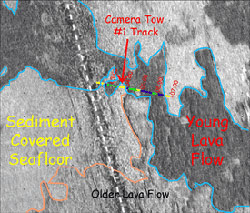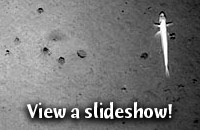|
Hot Topics: What Does a Young Galápagos Submarine Lava Flow Look Like? Mapping
lava flows with the MR1 side-scan sonar system is one thing — but
actually seeing them is even better!  MR1 sonar backscatter map for the area north and west of Fernandina. Darker areas of strong acoustic reflections from young lava flows and steep slopes facing the sonar fish. The red box shows the area blown up in the figure below.  Now it is time to see what one looks like! We selected a lava flow northwest of Fernandina volcano for our camera tow survey. We chose it because its strong (dark) reflectance on the MR1 side-scan sonar image suggested it might be very young. The lava flow is in 3100-3200 m of water, and is 19 km long -- very long for an underwater lava flow! We
towed the camera across a narrow part of the lava flow so that
we would see different parts of the seafloor covered with both
lava and sediment. The side-scan image shows the young, dark
lava flow outlined in blue. It has flowed over an older, sediment-covered
lava flow outlined in orange. Follow along the camera tow track as you look at photos of the seafloor in the slide show. The slides are in chronological order, starting from the left end of the camera track. Each photograph is approximately 4 meters by 6 meters in size.
|
|
© 2010 Dive and Discover™. Dive and Discover™ is a registered trademark of Woods Hole Oceanographic Institution
|
|

